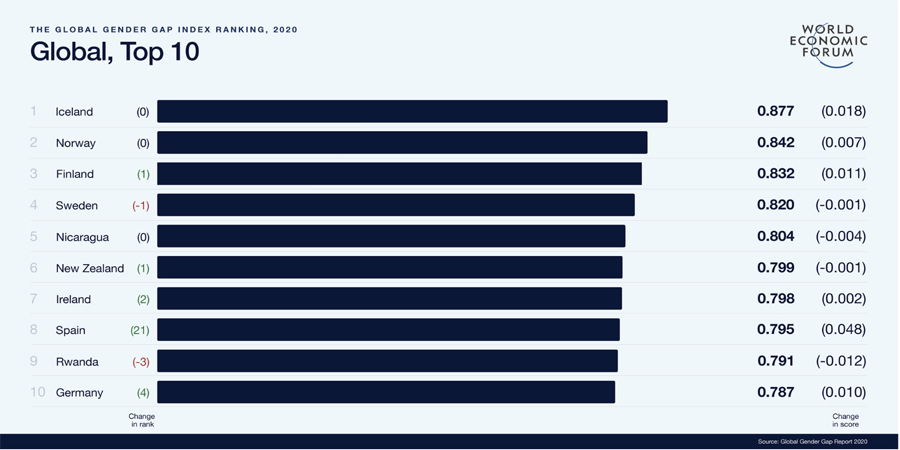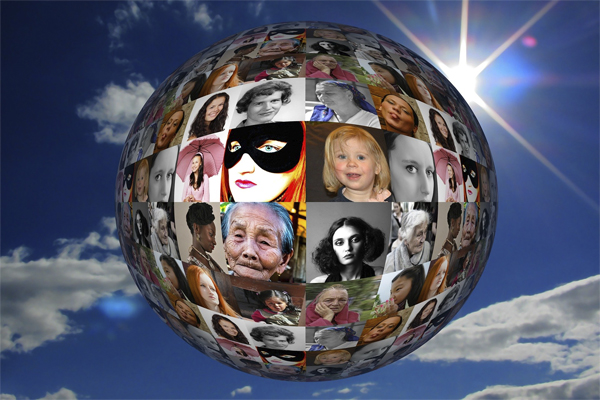Iceland remains the world’s most gender-equal country, according to the latest Global Gender Gap Report 2020, published by the World Economic Forum (WEF). The report also predicts that we will have to wait almost 100 years before we achieve gender parity, as reported.
In fact, the Nordic region continues to lead the way in gender parity, as Iceland is closely followed by Norway, Finland and Sweden. The other economies in the top 10 include Nicaragua (5th place), New Zealand (6th), Ireland (7th), Spain (8th), Rwanda (9th) and Germany (10th).
Spain made the biggest improvement in Western Europe, Ethiopia in Africa, Mexico in Latin America, and Georgia in Eastern Europe and Central Asia. These countries all improved their positions in the ranking by more than 20 places, largely driven by improvements in the political empowerment dimension, according to WEF.
Both the UK and US however, have slipped behind in this year’s global equality rankings. The UK now ranks 21st in the WEF global index, down from 16th the previous year. The US has also dropped to 58th position, down from last year’s 56th position.

WESTERN EUROPE
Western Europe is the best performing region for the 14th consecutive year. With an average score of 76.7% (out of 100), the region has now closed 77% of its gender gap, a further improvement on last year. At the current pace, it will take 54 years to close the gap in Western Europe, according to WEF.
The region is home to the four of the most gender-equal countries in the world – Iceland (87.7%), Norway (84.2%), Finland (83.2%) and Sweden (82.0%). Spain (now in 8th position) is also among the most improved countries that have made the biggest strides in equality this year.
NORTH & LATIN AMERICA & CARIBBEAN
Equality performance in both the US (72.4%, 53rd) and Canada (77.2%, 19th) has stalled, especially in terms of economic participation and opportunity. At this rate it will take 151 years to close the gap in those countries, according to WEF.
The Latin America and Caribbean region has closed 72.1% of its gender gap so far, progressing 1 percentage point, since last year. At this rate, it will take 59 years to close the gender gap here. The most noticeable improvement is on the political empowerment dimension, where the region closes its gap by 5 percentage points.
Led by Nicaragua, which has closed 80.4% of its gap (5th), 15 of the 24 countries in this region have improved their overall scores this year. Mexico is also among the countries which have made the most improvements, reducing its gender gap by 3.4 points on a year-by-year basis.
EASTERN EUROPE & CENTRAL ASIA
The Eastern Europe and Central Asia region has closed 71.5% of its gender gap so far, thanks to a slight improvement since last year. WEF estimates it will take around 107 years to fully close the overall gender gap in this region.
Around 21 of the 26 countries in this region have closed at least 70% of the gender gap. In fact, Latvia (11th) is the top-ranking country in the region, having closed its gap by 78.5%.
EAST ASIA & PACIFIC REGION
The East Asian and Pacific region has closed 69% of its overall gender gap. If this region maintains the same rate of improvement as the 2006-2019 period, it will take another 163 years to close the gender gap, confirms WEF.
The best performing country is New Zealand (6th), which has closed 79.9% of its gap, followed by the Philippines (16th) having closed 78.1% of its gap .
SOUTH ASIA
The South Asian region has closed two-thirds of its gender gap. The region’s gender gap is the second largest despite a progress of 6 points over the past 14 years. If the rate of progress of the past 15 years continues, it will take 71 years to close the region’s gender gap.
Bangladesh (50th) leads in this region’s index, while the second ranking country, Nepal, lags several positions behind (101th).
SUB-SAHARAN AFRICA
The Sub-Saharan Africa region has closed 68.0% of its gender gap so far. It has made significant progress, compared to last year, according to WEF, and estimates that this region will take around 95 years to close the gap.
The region is home to one of the top 10 countries in the chart – Rwanda (9th). Another 21 countries in the region have also improved their performance since last year, including Ethiopia (82nd) achieving one of the best improvements globally this year.
MIDDLE EAST & NORTH AFRICA
The Middle East and North Africa (MENA) region achieved the lowest score (61.1%), despite having narrowed its gap by 0.5 points since last year. Assuming the same rate of progress is made going forwards, it will take approximately 150 years to close the gender gap in this region, says WEF.
The two most highly ranked countries in the region are Israel (64th), which has closed the gender gap by 71.8% and the United Arab Emirates (120th) with a score of 65.5%. In addition, 15 of the 19 countries in this region rank 130th or lower in the global equality index.
Click here for a copy of the Global Gender Gap Report 2020.





































